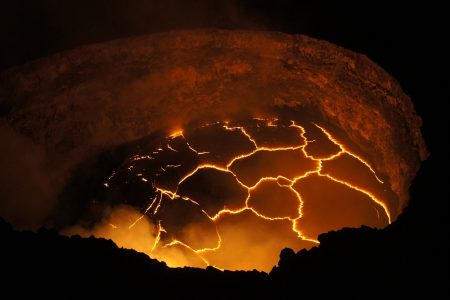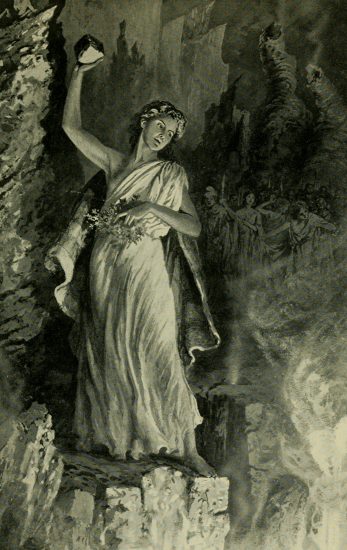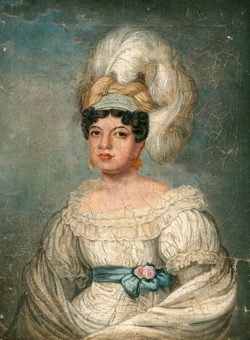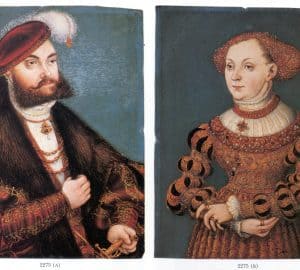
Down in the molten depths of the crater of Kilauea, a raging inferno yawned wide like the gates of hell. This fearful volcano on the big island of Hawaii had long been a source of superstition and fear for the natives. Centuries of tradition asserted that the goddess Pele lived in the volcano, and that her wrath would break out against anyone who broke Kapu, the ancient social rules of Hawaii. Recent volcanic activity had partially filled the crater with a lake of red-hot lava. The eruption seemed to confirm the suspicion that Pele was angry with the missionaries and the Hawaiians who had forsaken the old pagan ways to follow Jesus.
It was the fall of 1824. A high and royal chieftess named Kapiolani advanced to the brink of the fearful crater with a Christian missionary beside her. Kapiolani’s people, the natives of the Kona coast, watched in awe and dread as their chieftess reached out her hand and plucked berries from the sacred plant known as Ohelo. In a direct act of defiance to the rules of Kapu, she ate the sacred berries with no oblation to Pele, the goddess of the volcano. Instead, she paused at the brink of the crater and proclaimed:
My God is Jehovah. He it was who kindled these flames. I do not fear Pele. Should I perish by her wrath, then you may fear her power. But if Jehovah saves me while I am breaking Kapu, then you must fear and love Him. The gods of Hawaii are vain.
The bold chieftess carefully descended into the very heart of the crater itself, 500 feet down into the main crevice. The air was choked with sulfurous fumes rising from the molten lava, which was around 2,000 degrees Fahrenheit. The people watched in horror, expecting to see Kapiolani devoured by the wrath of an enraged goddess. Instead, they saw their chieftess seize chunks of solid lava and hurl them into the molten lake, defying the power of Pele to avenge herself. Kapiolani emerged from the crater victorious. Like Elijah on Mount Carmel, she had challenged the superstition of her day, and God had dramatically demonstrated his power as the Almighty King of Kings.

Kapiolani is best known to Hawaiian history for this dramatic act of courage and faith, but her entire life was a testimony to the power of the Gospel of Jesus Christ to transform a pagan culture for His glory. Kapiolani was born in 1781, when Hawaii was still in the darkness of superstition and fear. Captain Cook had discovered the islands only two years before her birth. She was the daughter of the high chief of the Hilo district on the big island of Hawaii. Her name means “arch of heaven” in reference to the rainbows that were seen after a tropical shower and which hovered over every mighty waterfall in the islands.
When Kapiolani was a little girl, her royal father, brothers, and cousins were involved in a war with the rival forces of King Kamehameha I, who was himself a distant cousin of the princess. She was spared from death as a girl when her caregivers threw her into the bushes to escape the marauding bands of enemy warriors. The young princess was raised by her royal aunt in the Kona district of the big island. As a girl, she was instructed in all the rigid social rules of Kapu. One rule forbade girls and women to eat bananas. Puzzled why she could not eat bananas, her young heart gave in to natural rebellion and curiosity. She compelled a servant boy to get her a banana. Hiding a piece of the fruit in her hand, she went into the sea to swim. While there, she ate the “forbidden fruit.” The eyes of a watching priest saw her eating the fruit, and he demanded punishment. Because she was a princess, Kapiolani was spared the death penalty, but the servant boy was taken into the dark gates of the pagan temple at Hoonaunau, and was never seen again. Kapiolani later found out that the servant boy had been offered as a human sacrifice to appease the gods.
Kapiolani was married to several husbands, sometimes simultaneously. She was beautiful, was of royal blood, and was deemed an important tool in the hands of the chiefs during those days when alliances were sealed by marriages. She lived in ignorance, superstition, and fear until the light of the Gospel penetrated the darkness of the islands.
In March of 1820, a ship called Thaddeus arrived in the islands. It carried a small band of missionaries from New England. Asa Thurston and his wife Lucy set up their station on the big island of Hawaii. Kapiolani was among their first converts. In the Gospel of Jesus Christ, Kapiolani found the hope and truth for which she had long groped in darkness. She renounced polygamy, settled down with Naihe, the man she considered her proper husband, learned to read and write, and became a sincere student of the Bible. She would often sit with the missionaries and weep as she thought on her former life, asking them with tears why they had not come sooner. She remembered her father, her mother, her brothers, who had all died in darkness. She remembered the servant boy who had been sacrificed to idols because of her own act of eating the forbidden bananas.

Her bold action at the Volcano of Kilauea in the autumn of 1824 broke the power of Pele in the islands. She abolished the laws of Kapu. She ended the practice of infanticide. She ended polygamy, and encouraged each Christian man to be faithful to his proper wife. She ordered the pagan temple of Hoonaunau cleansed of all its bones, its idols, and its demonic sacred objects. She instituted the Ten Commandments as the law of the land. She encouraged education. She loved sacred music, and wanted all her people to sing the praises of Jehovah. She donated land on which to build a large stone church. She provided a dwelling place for the missionaries. She gave of her royal wealth to support the work of the Gospel on the big island of Hawaii. She encouraged ranching and productive land management in her dominions. She started a garden on her own grounds and experimented with plants, including guavas, oranges, and coffee. Today, the area that she influenced is famous for Kona coffee.
After the death of her husband, Naihe, in 1831, Kapiolani moved uphill to live near the missionaries. One of the Thurston daughters sketched the silhouette of Kapiolani, the only authentic likeness that exists. For the rest of her life, she continued to be a faithful and consistent Christian, encouraging her people to find salvation, prosperity, and joy in following the ways of Jesus. Kapiolani developed a cancerous tumor and was operated upon by Dr. Gerritt Judd, the mission physician. No anesthetic was available, but Kapiolani submitted to the operation with calm trust. She seemed to recover for about six weeks, but she relapsed and died on June 5, 1841. Her life and testimony had transformed Hawaii forever. Darkness had turned to light. Despair had been replaced by hope. Superstition had given way to a firm confidence anchored in truth.





